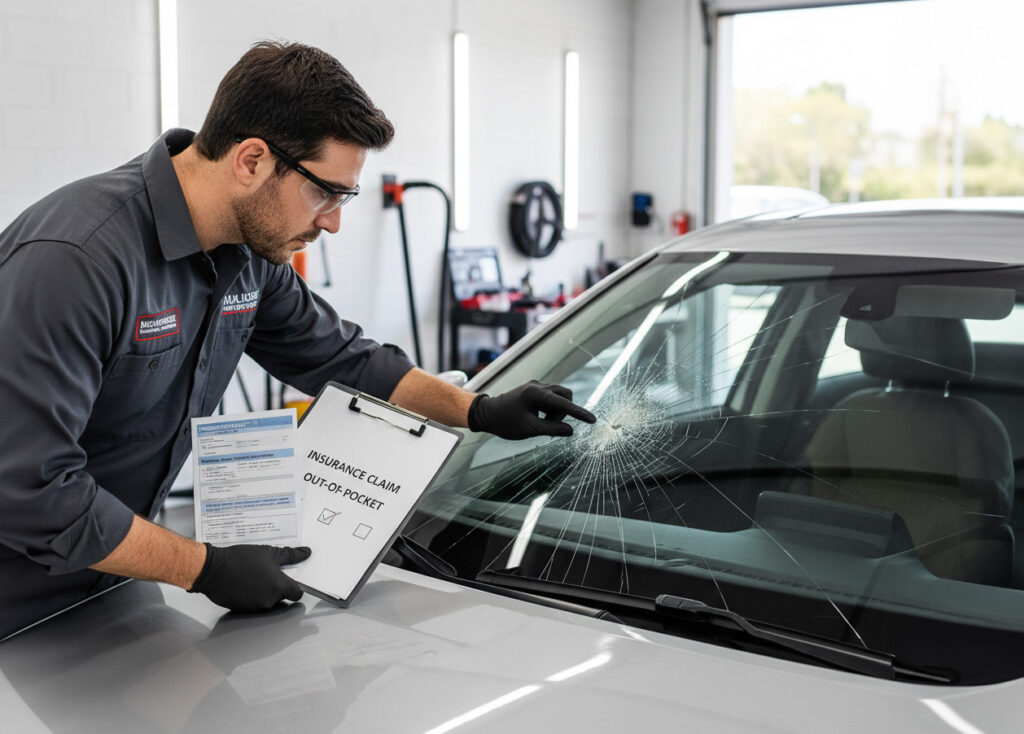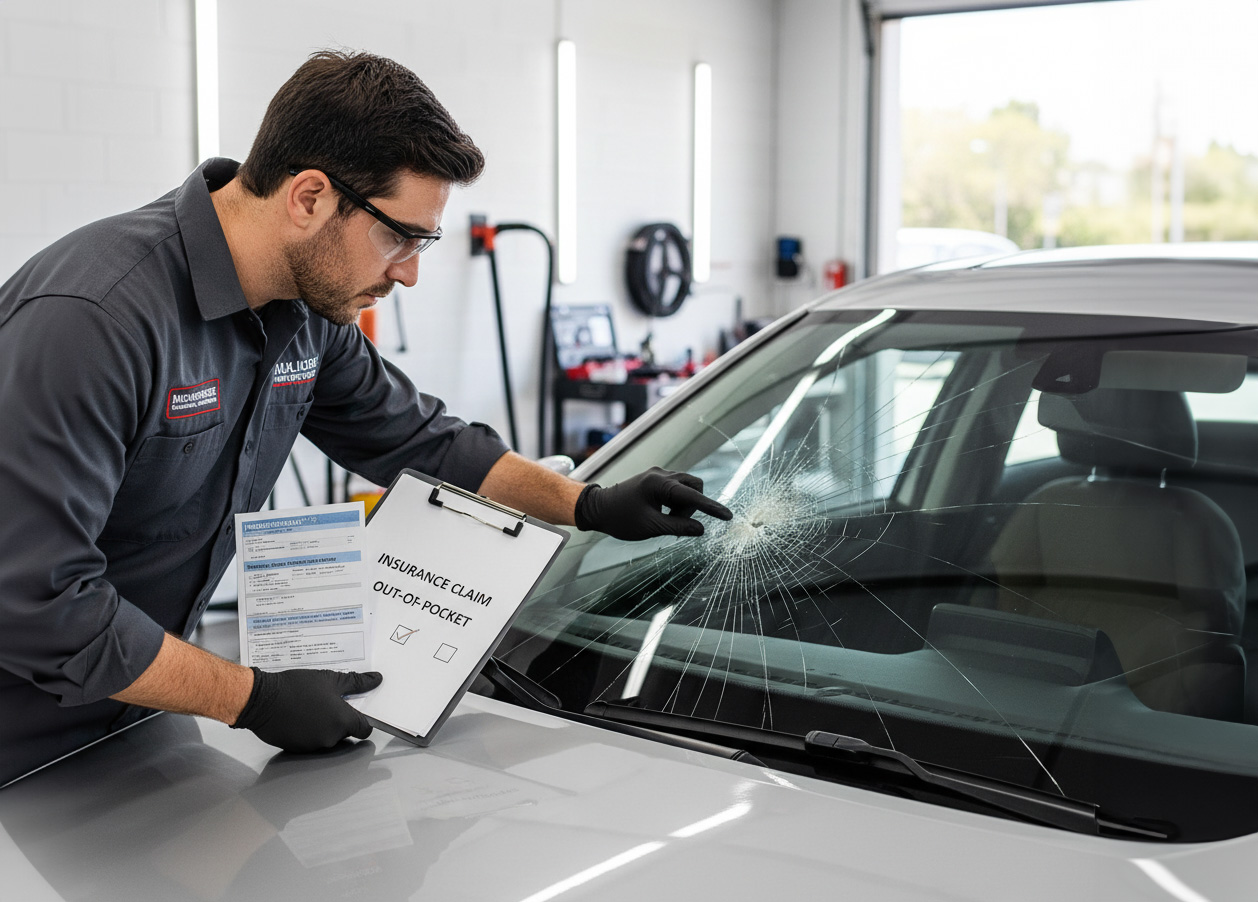Insurance or Out-of-Pocket? How to Decide for Windshield Replacement
When a crack spreads across your windshield or a rock chip suddenly turns into a spiderweb, the first thing you probably wonder is: “Should I use my insurance—or just pay for this out of pocket?”
It’s a common question, and the right answer depends on the type of damage, your insurance coverage, financial considerations, and how quickly you need the repair.
This guide breaks down everything you need to know to make the smartest, most cost-effective decision.
Why Windshield Replacement Matters More Than You Think
Your windshield isn’t just a sheet of glass. It’s a safety component that:
- Helps support the roof and cabin structure
- Works with airbags to deploy correctly
- Protects you from debris and road hazards
- Keeps the cabin sealed from wind, weather, and noise
- Ensures ADAS features like lane assist and forward collision warning function accurately
Even a small crack can compromise visibility or weaken the windshield’s structural integrity. That’s why experts recommend repairing or replacing damaged glass as soon as possible—before the crack spreads or creates unsafe driving conditions.
Understanding Your Insurance Coverage for Windshield Replacement
Before deciding how to pay, take a moment to review your car insurance policy. The type of coverage you have plays a major role in what you’ll pay out of pocket.
1. Comprehensive Coverage
This is the most important coverage when it comes to glass repair or replacement.
Comprehensive typically covers damage from:
- Road debris (rock chips)
- Vandalism
- Storms and hail
- Falling objects
- Animals
Depending on your state and insurer, you may have:
- Zero-deductible glass coverage
- Separate, lower deductibles for windshield claims
- Standard comprehensive deductible (often $250–$1,000)
2. Full Glass Coverage
Some insurers offer optional full glass coverage.
This usually means:
- No deductible
- Free repair or replacement
- No impact on your premiums
If you have this coverage, insurance is almost always the better option.
3. State Laws Matter
A few states require insurers to offer zero-deductible windshield replacement, regardless of your policy type.
These states include:
- Florida
- Kentucky
- South Carolina
In these states, using insurance is generally a no-brainer.
When It Makes Sense to Use Your Insurance
Using your insurance often provides the best value—but not in every situation. Here’s when it’s usually the smarter choice:
✔ The Replacement Cost Exceeds Your Deductible
Modern windshields—especially those with sensors, cameras, heated wipers, or heads-up displays—can cost $600 to $1,500+.
If your deductible is $250, $500, or even $1,000, insurance may significantly reduce your cost.
✔ You Have Zero-Deductible or Full Glass Coverage
This typically means:
- No cost to you
- No premium impact
- No reason to pay out of pocket
✔ The Damage Is Severe or Requires ADAS Recalibration
Cars with lane assist, forward collision warning, or other ADAS features often require camera recalibration after glass replacement.
Recalibration alone can add $150–$400 to the bill, making insurance the more affordable choice.
✔ You’re Concerned About Safety and Want OEM Glass
OEM (original manufacturer) windshields can cost significantly more than aftermarket.
Insurance can help cover the difference or may allow OEM glass when required for ADAS.
When Paying Out of Pocket Might Be Better
Insurance isn’t always the best route. Sometimes, paying cash can actually save money—or save you a headache.
✔ Your Deductible Is Higher Than the Replacement Cost
If your deductible is $1,000 and the windshield costs $450, using insurance won’t help.
✔ You Want to Avoid a Claim on Your Record
Even though comprehensive glass claims generally don’t raise premiums, some drivers prefer to avoid filing minor claims.
✔ You’re Getting a Small Rock Chip Repair
Most rock chip repairs cost $60–$120, while many insurers cover chip repairs for free.
However, if you don’t want to file a claim, paying out of pocket is inexpensive and quick.
✔ You Need the Job Done Fast
Insurance approvals sometimes take extra steps.
Paying out of pocket can speed up the process—especially if you’re on a tight schedule.
Cost Comparison: Insurance vs. Out-of-Pocket
| Situation | Best Option | Why |
| Windshield costs $800, deductible is $250 | Insurance | Lower out-of-pocket cost |
| Windshield costs $300, deductible is $500 | Out of pocket | Insurance won’t help |
| You have full glass coverage | Insurance | No deductible or cost |
| You need ADAS recalibration | Insurance | Saves $150–$400 |
| Minor chip repair | Either | Often free with insurance or inexpensive to pay cash |
How to Make the Decision Quickly
If you’re still unsure, ask yourself:
- What is my deductible?
- Do I have full glass coverage or zero-deductible coverage?
- Do I need ADAS recalibration?
- How much will the replacement cost?
- Do I care about using OEM vs. aftermarket glass?
- Do I want to file an insurance claim at all?
Once you know these answers, the right choice usually becomes clear.
Find the Best Price Before You Decide
Whether paying through insurance or out of pocket, getting multiple quotes can save a significant amount of money—and ensure you’re choosing a reputable shop.
Glass.net makes this easy.
Use Our Free Quote Tool
With just a few clicks, you can:
- Compare up to three trusted auto glass shops near you
- See price differences upfront
- Filter by mobile service, OEM glass options, and more
- Choose the shop that works best for your needs and budget
Get your free quote in minutes, and take the guesswork out of windshield replacement.

To read more, visit blog.glass.net

